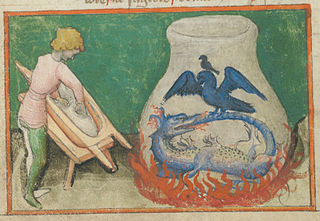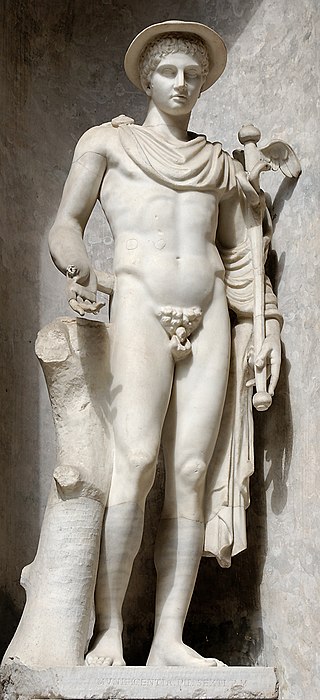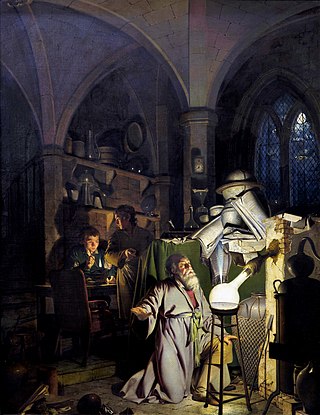Related Research Articles

Alchemy is an ancient branch of natural philosophy, a philosophical and protoscientific tradition that was historically practised in China, India, the Muslim world, and Europe. In its Western form, alchemy is first attested in a number of pseudepigraphical texts written in Greco-Roman Egypt during the first few centuries AD. Greek-speaking alchemists often referred to their craft as “the Art” (τέχνη) or “Knowledge” (ἐπιστήμη), and it was often characterised as mystic (μυστική), sacred (ἱɛρά), or divine (θɛíα).

Hermes is an Olympian deity in ancient Greek religion and mythology considered the herald of the gods. He is also widely considered the protector of human heralds, travelers, thieves, merchants, and orators. He is able to move quickly and freely between the worlds of the mortal and the divine aided by his winged sandals. Hermes plays the role of the psychopomp or "soul guide"—a conductor of souls into the afterlife.

Hermes Trismegistus is a legendary Hellenistic period figure that originated as a syncretic combination of the Greek god Hermes and the Egyptian god Thoth. He is the purported author of the Hermetica, a widely diverse series of ancient and medieval pseudepigraphica that laid the basis of various philosophical systems known as Hermeticism.

Thoth is an ancient Egyptian deity. In art, he was often depicted as a man with the head of an ibis or a baboon, animals sacred to him. His feminine counterpart was Seshat, and his wife was Ma'at. He was the god of the Moon, wisdom, knowledge, writing, hieroglyphs, science, magic, art and judgment.

The philosopher's stone is a mythic alchemical substance capable of turning base metals such as mercury into gold or silver; it was also known as "the tincture" and "the powder". Alchemists additionally believed that it could be used to make an elixir of life which made possible rejuvenation and immortality.

Hermeticism, or Hermetism, is a philosophical and religious tradition rooted in the teachings attributed to Hermes Trismegistus, a syncretic figure combining elements of the Greek god Hermes and the Egyptian god Thoth. This system encompasses a wide range of esoteric knowledge, including aspects of alchemy, astrology, and theurgy, and has significantly influenced various mystical and occult traditions throughout history. The writings attributed to Hermes Trismegistus, often referred to as the Hermetica, were produced over a period spanning many centuries and may be very different in content and scope.

The Hermetica are texts attributed to the legendary Hellenistic figure Hermes Trismegistus, a syncretic combination of the Greek god Hermes and the Egyptian god Thoth. These texts may vary widely in content and purpose, but by modern convention are usually subdivided into two main categories, the "technical" and "religio-philosophical" Hermetica.
Thaumaturgy, derived from the Greek words thauma (wonder) and ergon (work), refers to the practical application of magic to effect change in the physical world. Historically, thaumaturgy has been associated with the manipulation of natural forces, the creation of wonders, and the performance of magical feats through esoteric knowledge and ritual practice. Unlike theurgy, which focuses on invoking divine powers, thaumaturgy is more concerned with utilizing occult principles to achieve specific outcomes, often in a tangible and observable manner. It is sometimes translated into English as wonderworking.

Franz Bardon was a Czech occultist and student and teacher of Hermetics.
The Emerald Tablet, the Smaragdine Table, or the Tabula Smaragdina is a compact and cryptic Hermetic text. It was a highly regarded foundational text for many Islamic and European alchemists. Though attributed to the legendary Hellenistic figure Hermes Trismegistus, the text of the Emerald Tablet first appears in a number of early medieval Arabic sources, the oldest of which dates to the late eighth or early ninth century. It was translated into Latin several times in the twelfth and thirteenth centuries. Numerous interpretations and commentaries followed.

Wisdom literature is a genre of literature common in the ancient Near East. It consists of statements by sages and the wise that offer teachings about divinity and virtue. Although this genre uses techniques of traditional oral storytelling, it was disseminated in written form.

Mary or Maria the Jewess, also known as Mary the Prophetess or Maria the Copt, was an early alchemist known from the works of Zosimos of Panopolis and other authors in the Greek alchemical tradition. On the basis of Zosimos's comments, she lived between the first and third centuries A.D. in Alexandria. French, Taylor and Lippmann list her as one of the first alchemical writers, dating her works at no later than the first century.

Zosimos of Panopolis was a Greek alchemist and Gnostic mystic who lived at the end of the 3rd and beginning of the 4th century AD. He was born in Panopolis, and flourished ca. 300. He wrote the oldest known books on alchemy, which he called "Cheirokmeta," using the Greek word for "things made by hand." Pieces of this work survive in the original Greek language and in translations into Syriac or Arabic. He is one of about 40 authors represented in a compendium of alchemical writings that was probably put together in Constantinople in the 7th or 8th century AD, copies of which exist in manuscripts in Venice and Paris. Stephen of Alexandria is another.

This is a comparative religion article which outlines the similarities and interactions between Hermeticism and other religions or philosophies. It highlights its similarities and differences with Gnosticism, examines its connections in Islam and Judaism, delves into its influence on Christianity, and even explores its potential impact on Mormonism. In essence, it unveils how Hermeticism has engaged with, influenced, and been influenced by a diverse array of spiritual and philosophical traditions throughout history.
Psychology and Alchemy, volume 12 in The Collected Works of C. G. Jung, is Carl Jung's study of the analogies between alchemy, Christian dogma, and psychological symbolism.

Idris is an ancient prophet mentioned in the Qur'an, who Muslims believe was the third prophet after Seth. He is the third prophet mentioned in the Quran. Islamic tradition has unanimously identified Idris with the biblical Enoch. Many Muslim scholars of the classical and medieval periods held that Idris and Hermes Trismegistus were the same person.

In alchemy, the Magnum Opus or Great Work is a term for the process of working with the prima materia to create the philosopher's stone. It has been used to describe personal and spiritual transmutation in the Hermetic tradition, attached to laboratory processes and chemical color changes, used as a model for the individuation process, and as a device in art and literature. The magnum opus has been carried forward in New Age and neo-Hermetic movements which sometimes attached new symbolism and significance to the processes. The original process philosophy has four stages:
Hermeticism in poetry, or hermetic poetry, is a form of obscure and difficult poetry, as of the Symbolist school, wherein the language and imagery are subjective, and where the suggestive power of the sound of words is as important as their meaning. The name alludes to the mythical Hermes Trismegistus.

Cleopatra the Alchemist was a Greek alchemist, writer, and philosopher. She experimented with practical alchemy but is also credited as one of the four female alchemists who could produce the philosopher's stone. Some writers consider her to be the inventor of the alembic, a distillation apparatus.

Giovanni Mercurio da Correggio was an Italian itinerant preacher, Hermeticist, and alchemist. Due to his bizarre appearance in Rome on Palm Sunday 1484 he has been believed by some scholars to have not actually existed, but this has been contested with other reports that corroborate his eccentricities. His most notable follower was Lodovico Lazzarelli, an Italian humanist poet and alchemist, who writes his accounts of da Correggio in his Epistola Enoch.
References
- ↑ Elizabeth Potter Gender and Boyle's law of gases - 210 pages Indiana University Press, 1 Jun 2001 ISBN 0-253-33916-2
- ↑ Kathleen P. Long Gender and scientific discourse in early modern culture - 313 pages. Ashgate Publishing, Ltd., 30 Nov 2010. 2010. ISBN 9780754669715 . Retrieved 2012-02-05. ISBN 0-7546-6971-8
- ↑ (Joseph H. Peterson ed., with analyses) The Lesser Key of Solomon:Lemegeton Clavicula Salomonis - 304 pages Weiser Books, 1 May 2001 Retrieved 2012-02-06 ISBN 1-57863-220-X
- ↑ Stanton J. Linden The alchemy reader: from Hermes Trismegistus to Isaac Newton p.228,229. Cambridge University Press, 28 Aug 2003 ISBN 0-521-79662-8 Retrieved 2012-02-07